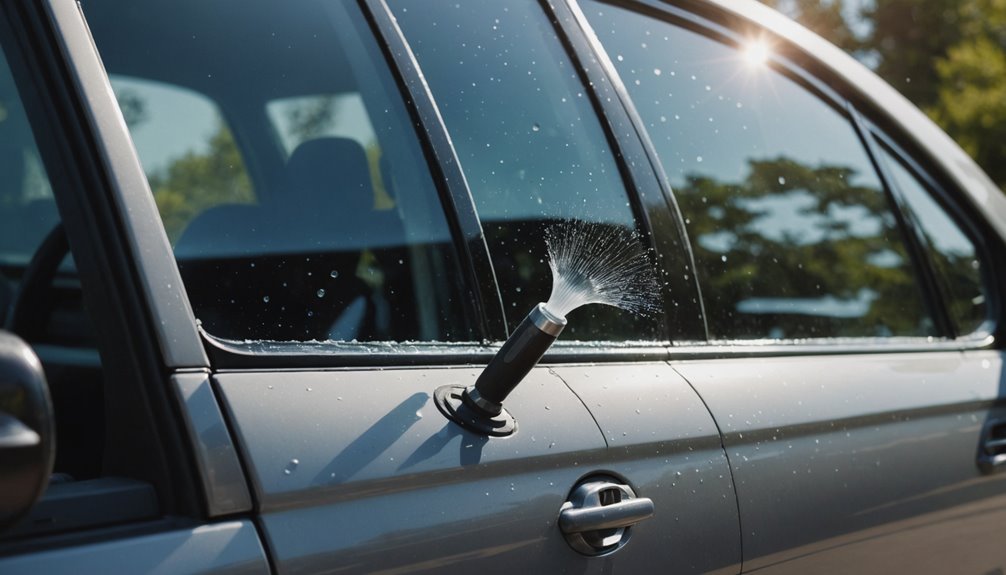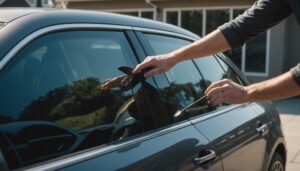Removing tint from a car window can seem challenging, but with the right approach, it’s manageable. You’ll want to gather your tools and choose a well-lit workspace before getting started. With the right technique, you can efficiently peel away the old film and restore your windows. But how do you tackle the adhesive residue left behind? Understanding the steps can make a significant difference in achieving a clear finish.
Key Takeaways
- Use a heat gun or hairdryer to loosen the adhesive for easier tint removal.
- Begin at the corners, lifting the tint carefully to avoid tearing.
- Remove any adhesive residue using a dedicated adhesive remover or spray.
- Clean the window thoroughly with soapy water and a microfiber cloth.
- Finish with glass cleaner and polish for a clear, pristine surface.
Gather Your Tools and Materials
Before you plunge into removing tint from your car windows, it’s vital to gather your tools and materials. You’ll need a heat gun or hairdryer, which helps loosen the adhesive. A utility knife or razor blade is essential for cutting the film, so have that ready too.how-much-does-it-cost-to-wrap-a-car
Don’t forget about a spray bottle filled with soapy water; this will make it easier to peel off the tint. Grab some gloves to protect your hands, and paper towels or rags to catch any residue. You might also want a plastic scraper or card to help lift the film without risking damage to the glass.
Having these tools at the ready will streamline the process, making it smoother and more efficient. Finally, consider having a trash bag nearby for any discarded tint and materials. With everything in hand, you’ll be prepared for a successful tint removal experience.
Prepare Your Car for Tint Removal
To prepare your car for tint removal, start by finding a suitable workspace with ample light and ventilation.
Make certain the area is free of dust and debris to avoid any scratches while you work. You’ll also want to park your car in a location that’s protected from direct sunlight, as this can make the adhesive harder to remove.
Next, roll down the windows slightly to give you better access to the edges of the tint.
Before you engage, it’s a good idea to remove any accessories, like window visors or seat covers, that may get in your way.
Clear the interior of your vehicle to guarantee you’re not distracted during the removal process.
Finally, keep a damp cloth handy to catch any adhesive residue that may fall onto the seats or floor.
This preparation sets you up for a smoother tint removal experience.
Choose the Right Technique for Your Tint
Selecting the right technique for removing tint is essential, especially since different types of tint require different approaches.how-many-volts-is-a-car-battery
You’ll first need to identify whether you’re dealing with dyed, metalized, or ceramic tint. Dyed tints are usually the easiest to remove, as they peel off fairly quickly. Metalized tints can be more stubborn due to the adhesive used, while ceramic tints are the most challenging because of their strong bond and potential for damaging the glass if not handled carefully.
Once you determine the type of tint, choose your removal method. You can use the heat method, which involves applying heat to loosen the adhesive, or the steam method, which helps lift the tint using steam.
If you’re unsure or feel uncomfortable, consider consulting a professional who can guarantee a safe and effective removal. This way, you’ll avoid damaging your windows during the process.
Step-by-Step Tint Removal Process
Once you’ve chosen the appropriate method for tint removal, it’s important to gather all necessary materials before starting the process. Here’s a step-by-step guide to help you:
| Step | Action | Tips |
|---|---|---|
| 1 | Heat the Tint | Use a hairdryer or heat gun |
| 2 | Loosen Edges | Pick at the corners with tape |
| 3 | Peel Off Tint | Pull slowly at an angle |
| 4 | Remove Residue | Use adhesive remover |
| 5 | Clean the Window | Wipe with window cleaner |
Follow these steps carefully to avoid damaging your windows. Stay patient; the process might take some time depending on the tint’s quality. Always work in a well-ventilated area to guarantee safety. Enjoy your newly clear windows!how-to-disconnect-a-car-battery
Clean and Refinish the Windows After Tint Removal
After successfully removing the tint, it’s important to focus on cleaning and refinishing your windows. Start by washing the glass with a mixture of warm water and mild soap. Use a soft microfiber cloth to avoid scratching the surface. Thoroughly rinse the glass to eliminate any soap residue.
Next, examine your windows for any adhesive residue left behind. If you find any, use a razor blade or a plastic scraper to gently remove it without damaging the glass.
Afterward, apply a glass cleaner specifically designed to remove adhesives, and wipe it down with another clean cloth.
Finally, for a polished finish, consider using a glass polish. Apply it according to the product instructions, and buff it out with a microfiber cloth. This step not only enhances clarity but also protects your windows from future grime and smudges.
Your windows will look brand new and pristine!
Frequently Asked Questions
How Long Does It Take to Remove Window Tint?
Removing window tint usually takes about 1 to 3 hours, depending on the size of the window and the type of tint.
If you’re doing it yourself, make sure you have the right tools, like a heat gun or steamer, to speed up the process.how-much-is-a-car-battery
If you hired a professional, they might complete it quicker.
Just be patient, as it can get a bit tricky, especially with older tints that have adhesive residue.
Can I Remove Tint Without Damaging the Windows?
Yes, you can remove tint without damaging the windows if you do it carefully.
Start by using a heat gun or hairdryer to warm the tint, which helps loosen the adhesive. Gently peel it away, taking your time.
If the adhesive remains, you can use glass cleaner or a razor blade with caution. Just be sure to avoid pressing too hard to prevent scratching the glass.
Always work slowly and methodically for the best results.
What Is the Best Time of Year for Tint Removal?
The best time of year for tint removal is during warmer months, like spring or summer.
Temperatures between 70°F and 90°F make the process easier, as the heat helps loosen the adhesive.
Avoid extreme temperatures, as cold can make the film brittle and harder to remove.
Planning your tint removal when it’s warm outside can save you time and frustration, ensuring you can effectively deal with any mess left behind.
Is Professional Removal Better Than DIY Methods?
Yes, professional removal is often better than DIY methods. You might save time and guarantee a high-quality finish when experts handle it.how-much-does-it-cost-to-wrap-your-car
Professionals have the right tools and experience to avoid damaging the glass or leaving residue. If you’re unsure or it’s your first time, opting for a professional can reduce stress.
However, if you’re handy and ready to learn, DIY can be a fun project, as long as you take the right precautions.
Are There Any Legal Restrictions on Window Tint?
Yes, there are legal restrictions on window tint, and they vary by state or region. You’ll need to check local laws to find out the maximum allowable tint percentage for your car’s windows.
Some areas might have specific rules about reflective tints as well. It’s essential to comply with these regulations to avoid fines or issues during inspections.
Keeping your car within legal limits guarantees you stay safe and stylish on the road.
Conclusion
Removing tint from your car windows can seem challenging, but with the right tools and technique, it’s totally manageable. Remember to work slowly and carefully to avoid any damage. Once you’ve peeled off the tint and cleaned up the adhesive, you’ll be left with crystal-clear windows. Enjoy your refreshed look! By following these steps, you’ve not only improved visibility but also maintained your car’s appearance. Now you’re all set to hit the road with confidence!













